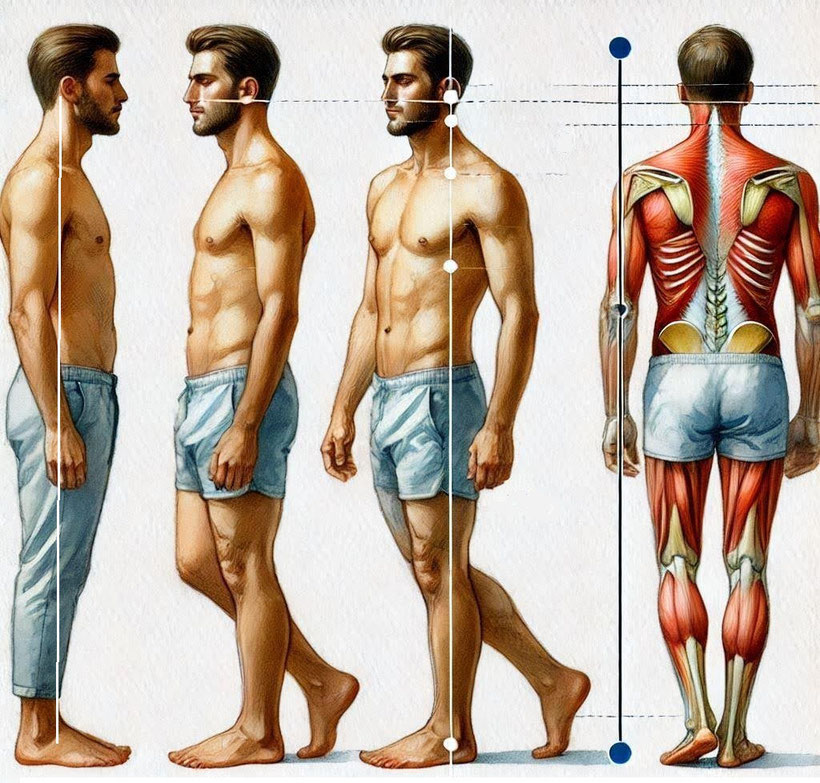Posture is often thought of as a static position – how you hold yourself while sitting or standing. However, the Alexander Technique challenges this notion by showing that posture is not a static position to be held rigidly, but is fundamentally intertwined with movement.
The Alexander Technique: A Brief Overview
The Alexander Technique is an educational method that teaches improved coordination, support and movement by reducing patterns of interference to natural functioning. It shows you how to unlearn harmful habits and achieve a more naturally supported and dynamic body. Rather than encouraging "correct" positions, the technique improves how you move throughout your daily activities in dynamic balance.
The Dynamic Nature of Posture
We are constantly in motion, even when seemingly still. Whether sitting, standing, or even lying down, our bodies are engaged in a continuous dance of coordination. The Alexander Technique recognizes that commonly held attitudes towards posture is like a snapshot of this ongoing movement.
Traditional views of posture often treat it as a fixed position. How often have you been told told to "hold" your posture in a certain way, leading to stiffness and discomfort. The Alexander Technique challenges this notion by considering posture as a continuous, fluid movement. This dynamic approach recognizes that our bodies are constantly in motion, even when we appear to be still.
There's a trade off between stability and mobility, the more you have of one, the less you have of the other. Humanity has taken the mobility route in its evolution (compare that with a tortoise!), which leaves us inherently unstable. We find our "stability" through movement itself, always adjusting and readjusting, re-finding the support offered by the ground spontaneously in the moment. Standing is a balancing act, and balancing is a movement.
You may have seen articles on posture where a picture is provided showing a person side on. A plumb line connecting the ears, shoulder, hips, knees and ankles is usually added. Images like these can be misleading. The mistake is in thinking that you're supposed to achieve that plumb line, you are not. What that line really represents is one of two things; the average of all the points you've wobbled about, or, the line of upwards (yes, upwards!) support being offered by the ground. The latter requires a whole other discussion on the true nature of gravity and how we've evolved to use it to our advantage.
So why are you still in movement when lying down? Because you're breathing (hopefully). The ribcage articulates with the spine, and the diaphragm also connects to the spine, causing a natural wave of movement along the spine as you breath. When standing, and sitting upright, this additional movement causes further instability that your balance mechanisms have to adjust for, through movement! It is possible to feel this subtle movement of the spine, I can observe my own as I sit here typing this, but I do have to make a conscious choice to observe it. It can be easier to observe when lying down in Semi-supine/Constructive Rest as the floor provides tactile feedback to the movement. It's also helpful to exaggerate the movement by taking long out breaths, which also down regulates your nervous system. I recommend everyone spends some time in Constructive Rest performing long out breaths, not only to calm you down, but to enjoy the freedom and movement of a healthy spine in a way that feels safe if you've developed the unhelpful habit of "protecting" your spine through rigidity.

Alexander Technique Principles
- Primary Control: A key concept in the Alexander Technique is the idea of Primary Control, which refers to the relationship between the head, neck, and spine. Alexander found that this psychophysical relationship is crucial for overall coordination and balance. Why "psycho"-physical? because the quality of your thinking and nervous system affects muscle tone and reactivity. When you react, you tighten. By maintaining a dynamic, balanced relationship between these parts, you can achieve a more natural and efficient posture. Better still, by working on the mental aspects you can achieve real poise.
- Inhibition and Direction: The technique employs two key principles: Inhibition and Direction. Inhibition involves pausing to prevent automatic, habitual responses that interfere with natural movement. Direction involves consciously guiding the body into a more coordinated state. Together, these principles help you develop a fluid and responsive posture.
- True Primary Movement: This is a term that Alexander coined to describe the movement of the torso in breathing. For reasons unknown, he dropped the use of the phrase, so it's not in common usage, but I like it and chose to use it still. Posture is intimately connected with breathing. The Alexander Technique encourages free and easy breathing, which is facilitated by a dynamic posture. When we view posture as movement, we allow for the natural rise and fall of the chest and the subtle shifts in the body's balance, leading to more effective breathing.
Practical Applications
The benefits of viewing posture as movement extend to various aspects of daily life and activities. Here are some practical applications:
- Standing: Standing becomes a dynamic act of balance rather than a static pose. By consciously releasing tension and allowing the body to find its natural support, standing feels more effortless and stable.
- Sitting: Instead of rigidly holding a "correct" sitting position, the Alexander Technique encourages you to sit with a sense of fluidity. In fact, as far as your spine is concerned, sitting and standing are the same thing, except you have a more stable base when sitting. This reduction in available movement, and increased stability, can encourage a sense of rigidity, so being more attuned to the available movement is key. For clarity, I differentiate between sitting and reclining. Sitting is active, reclining passive.
- Walking: Walking is a series of complex coordinated movements, and the Alexander Technique helps refine these movements by recognizing and reducing interference patterns, rather than trying to walk "correctly". By being mindful of the Primary Control and maintaining a sense of upwards direction, walking becomes smoother and less tiring. When you go from standing to walking, you go from movement, to movement.
- Performance and Sports: Musicians, actors, and athletes can all benefit from the Alexander Technique. By understanding posture as movement, you can enhance your performance, reduce the risk of injury, and achieve greater expressive potential.
The Alexander Technique offers a truer perspective on posture, viewing it not as a static position but as a dynamic and ongoing process. This approach helps you move with greater ease, efficiency, and grace, positively impacting your overall health and well-being. By embracing posture as movement, you can unlock a new level of physical and mental harmony.
Whether in everyday activities or specialized performance, the Alexander Technique teaches you to live with greater awareness and coordination, leading to a more balanced and life.

Write a comment